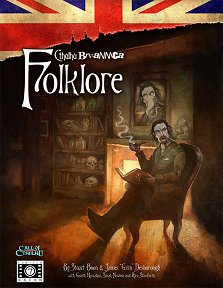
Britain has loads of folklore and, if you look at it in a certain way, you can twist it to your own uses in running a Call of Cthulhu game. Wherever you go, there are myths and legends, tales of the faerie folk, monsters and all manner of supernatural things. They're most rooted to certain locations and it's not too far a leap to say that if there is any basis in reality, the Mythos might be involved... and this book explores such a concept with a whole bunch of ideas for you to use.
The Introduction explains this, with an academic grounding and further references for the interested reader. Then Folklore: A Closer Look delves into the whole concept of what folklore actually is, the remarkable creativity of the human mind when, untrammeled by too much 'common sense' or scientific knowledge, it attempts to explain the world around it and the odd things that go on there. Such tales were still going strong in the 1920s, and people were beginning to collect them - there's a new skill, Folklorist, for anyone who wants their character to take an interest.
Next, Using Folklore in Call of Cthulhu Games looks at how it can add depth and excitement, grounding the plot in a context that is familiar. There are various ways that you can use it. The most obvious one is to have a local folk tale have an origin in something Mythos-related. However, perhaps there's a folklore story running parallel to your Mythos-based one - local colour, perhaps, or a complete red herring to confuse the investigators. At times the discussion is a bit dry and academic, but it gives a good grounding in a range of different ways of involving folklore that may not all have occurred to you before. Folklore always raises more questions than it answeres...
The rest of the book provides an array of ideas which can inspire (or just be used outright) your games, starting with Using Folk Magic in Call of Cthulhu games. Folklore is full of magic - magical events, beings that can wield magic and so on. The Mythos too has its magic: but how do they interrelate? Perhaps folk magic is the present-day relic of ancient lore passed down by Mythos beings, or maybe it developed independently as human beings learned to manipulate powers themselves having seen that such powers existed and could be manipulated... Again, more questions than answers, but by pondering them you can figure out what works (and what is mere superstition) in your game. There are plentiful examples to help you decide, and notes on the allied field of folk medicine. To some, folk medicine is wrapped up in magic, for others it is an instinctive knowledge of the properties of plants applied to the healing arts.
Next is A Folklore Bestiary. It provides details of an assortment of common spirits, monsters, creatures, and peoples of folklore complete with notes on how they may have Mythos connections and all the necessary statistics for you to incorporate them into your game. After all, even if they don't have a Mythos connection, if the Mythos is real, so might they be real and able to show up where appropriate! Faerie folk, giants, wizards, shapeshifters and more await you here... not to mention ghosts and other spirits, and strange beasts such as Black Dogs, a common feature of folklore, along with water horses, dragons and of course the Wild Hunt. Plenty of material here to inspire you.
This is followed by The Folklore Calendar. We cannot have our beasties turning up at the wrong time - or if we do, there must be a plot-driven reason that might give the insvestigators a clue as to what is going on. Then Old Ones and Old Gods looks at Mythos figures in terms of how they might feature as the tradional deities (and other powerful beings) in folklore.
Folklore Mythos Threats continues this theme with information on the activities and motivations of a number of Mythos threats lurking behind British folklore in the 1920s. Find out what the Beast of Bodmin might actually be... presented in enough detail for you to run this as an adventure, complete with a few NPCs and events to throw into the mix. There are other pieces in similar vein, scenario outlines at least, concerning an ancient skull, strange finds in chalk downs and a farmer whose plough dug a little too deep one day. There are strange sightings off the coast of Devon and Cornwall which may not be smugglers for once, and strange goings-on associated with a group of tinkers and missing bodies, not to mention a disappearance in the Fenlands that is decidedly suspicious and the appearance of the Allendale Wolf, larger and more ferocious than any normal animal, or a vast cave system in Wales that is said to be an entryway to Fairyland.
Even if you find the earlier chapters too abstract and philosophical for your taste, this last section provides a wealth of material that you can incorporate into your game. Perhaps you will drop one in occasionally to an existing campaign, or use them as a basis for an entire folklore-related series of adventures... whatever you choose, you'll never listen to a folktale in quite the same way again!
Return to Cthulhu Britannica: Folklore page.
Reviewed: 23 December 2017

